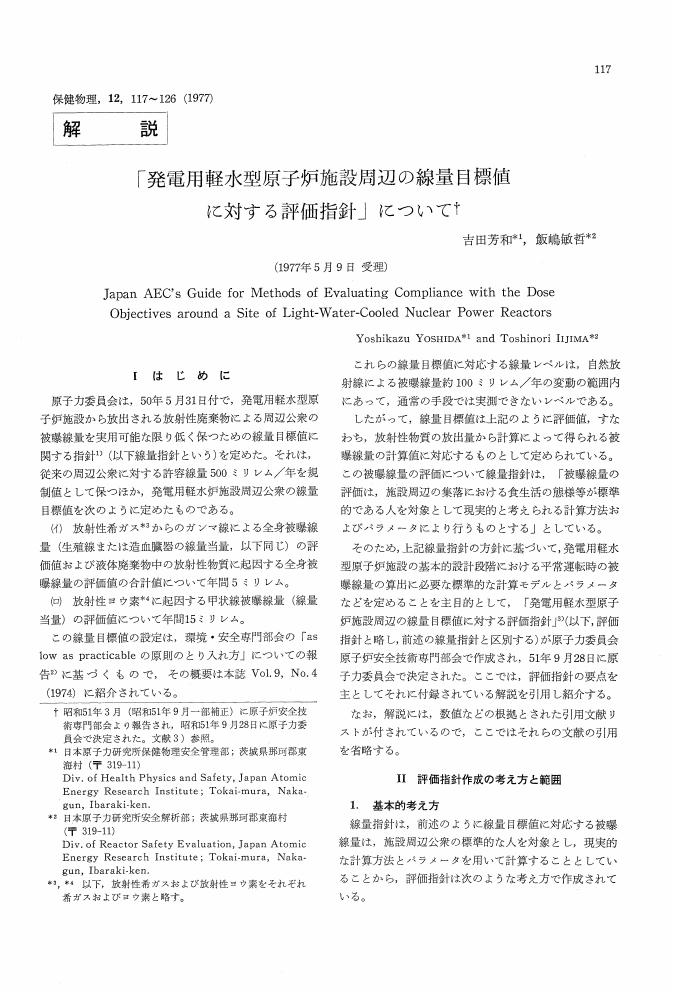6 0 0 0 OA 原子力発電所周辺に栽植したムラサキツユクサの突然変異率の変動
- 著者
- 山口 彦之 吉田 芳和 田野 茂光 備後 一義 片桐 浩
- 出版者
- 日本保健物理学会
- 雑誌
- 保健物理 (ISSN:03676110)
- 巻号頁・発行日
- vol.20, no.4, pp.349-356, 1985 (Released:2010-02-25)
- 参考文献数
- 23
Tradescantia (clone KU-7) were grown at three points near a site of nuclear power plants and somatic mutation frequencies in Tradescantia stamen hairs were investigated for three years. The two points are located in the prevailing down-wind sector of the site. Mutational events in stamen hair cells were scored every day from the end of April to October for three years. In parallel with this observation, factors which have been thought to affect mutation induction, such as temperature, humidity, insolation, pollutants, radioactivity in the buds were measured at the three points. The daily exposure and radioactive concentration at three points due to the amount of the radioactive nuclide released from the nuclear power plant were calculated.Mutation frequencies fluctuated daily, but they were estimated rather constant on average at three sites. Increase of radioactivities in the buds or other plant tissues was not detected during this experiment. The daily exposure and radioactive concentration were very low, for example, the ratio of the maximum daily exposure to the doubling dose was less than 1×10-7.It has been definitely shown by this field experiment that radionuclide released from the nuclear power plants can not induce significant mutation of Tradescantia.It was concluded that Tradescantia stamen hair system was not appropriate to monitor the environmental radiation from the power reactor.
2 0 0 0 OA 「発電用軽水型原子炉施設周辺の線量目標値に対する評価指針」について
1 0 0 0 原子力発電所周辺に栽植したムラサキツユクサの突然変異率の変動
- 著者
- 山口 彦之 吉田 芳和 田野 茂光 備後 一義 片桐 浩
- 出版者
- 日本保健物理学会
- 雑誌
- 保健物理 (ISSN:03676110)
- 巻号頁・発行日
- vol.20, no.4, pp.349-356, 1985
<i>Tradescantia</i> (clone KU-7) were grown at three points near a site of nuclear power plants and somatic mutation frequencies in <i>Tradescantia</i> stamen hairs were investigated for three years. The two points are located in the prevailing down-wind sector of the site. Mutational events in stamen hair cells were scored every day from the end of April to October for three years. In parallel with this observation, factors which have been thought to affect mutation induction, such as temperature, humidity, insolation, pollutants, radioactivity in the buds were measured at the three points. The daily exposure and radioactive concentration at three points due to the amount of the radioactive nuclide released from the nuclear power plant were calculated.<br>Mutation frequencies fluctuated daily, but they were estimated rather constant on average at three sites. Increase of radioactivities in the buds or other plant tissues was not detected during this experiment. The daily exposure and radioactive concentration were very low, for example, the ratio of the maximum daily exposure to the doubling dose was less than 1×10<sup>-7</sup>.<br>It has been definitely shown by this field experiment that radionuclide released from the nuclear power plants can not induce significant mutation of <i>Tradescantia</i>.<br>It was concluded that <i>Tradescantia</i> stamen hair system was not appropriate to monitor the environmental radiation from the power reactor.
1 0 0 0 OA 740. 放射性ヨウ化メチルの光分解と元素状ヨウ素および他のヨウ素種の生成
- 著者
- 野口 宏 松井 浩 吉田 芳和
- 出版者
- 一般社団法人 日本原子力学会
- 雑誌
- 日本原子力学会誌 (ISSN:00047120)
- 巻号頁・発行日
- vol.24, no.5, pp.381-389, 1982-05-30 (Released:2010-01-08)
- 参考文献数
- 16
In appropriate evaluation of the internal dose of a population due to radioiodine released from a nuclear power plant during normal operation, it is necessary to clarify behavior of radioiodine in the environment. Sunlight appears to be one of the major factors in the chemical form changes, particularly for radioactive methyl iodide.In the present work, photodissociation of gaseous methyl iodide and production of elemental iodine and other iodine species under the sunlight-simulated white light from a xenon lamp in various atmospheric conditions were studied. Methyl iodide dissociated exponentially with the product of the intensity of light and the irradiation time. The dissociation of methyl iodide produced mainly elemental iodine, and other iodine species (e.g. particulate iodine) up to about 10% in relatively low concentration (less than 10-9g/cm3) of methyl iodide. The effect of relative humidity on the reaction was not observed.
